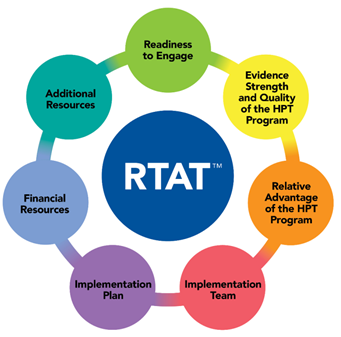Readiness to Train Assessment Tool™


About the Tool
The Readiness to Train Assessment Tool (RTAT) is a 41-item, 7-subscale validated survey instrument that covers dimensions of health center readiness for engaging with Health Professions Training (HPT) programs that were deemed critical to evaluate by subject matter experts.
The RTAT uses the following definition of organizational readiness: ‘the degree to which health centers are motivated and capable to engage with and implement a health professions training program’.
Click here to learn more about the development of the RTAT tool.
Click here to learn more about the latest project updates.
The Seven Subscales of the RTAT
| Sub-scale | Brief Description |
|---|---|
| Readiness to Engage | Indicators of the health center’s overall readiness and commitment to engage with health professions training. |
| Evidence, Strength & Quality of the HPT Program | Stakeholders’ perceptions of the quality and validity of evidence supporting the belief that the HPT program will have desired outcomes at their health center. |
| Relative Advantage of the HPT Program | Stakeholders’ perceptions of the advantage of engaging with/implementing the HPT program versus an alternative solution. |
| Financial Resources | The level of financial resources dedicated for implementation and ongoing operations. |
| Additional Resources | The level of additional resources dedicated for implementation and on-going operations, including appropriate staff and assistance for staff (e.g. evaluation resources, tools, training, and coaching). |
| Implementation Team | This subscale is about the individuals involved with the HPT implementation process who can formally or informally influence this process through their knowledge, attitudes, and behaviors. They are effective in overcoming indifference or resistance that the implementation of an HPT program may provoke in the health center. |
| Implementation Plan | This subscale is associated with the implementation process. Successful engagement usually requires an active change process aimed to achieve effective implementation of the HPT program(s). The subscale measures the degree to which a scheme or method of behavior and tasks for implementing an HPT program are developed in advance, and the quality of those schemes or methods. |
Why Use the RTAT
The RTAT meets a need at the national level to help health centers address concerns regarding capacity, resources, and organizational abilities when launching any health professions training program(s). It can support implementation of HPT programs at health centers and serve as a platform meant to encourage dialogue and action at various levels.
The advantage of using the RTAT is that it covers organizational readiness dimensions that are relevant to all kinds of health professions training programs and types of health centers.
“I strongly encourage everyone to complete the Readiness to Train Assessment Tool. It will provide valuable individual insight to your health center’s recruitment and training capabilities. The resulting Strategic Workforce Plan that you develop—including types of residency and trainee programs you want to implement—can help you expand your workforce to meet your future needs.”
— Jim Macrae, Associate Administrator, Bureau of Primary Health Care
“This initiative strengthens workforce development and training at health centers by providing health professions students and residents with training customized for the needs of the community they serve.”
— Luis Padilla, Associate Administrator, Bureau of Health Workforce; Director, National Health Service Corps
Get Started
Initial survey distribution is being done by the Primary Care Association (PCA) in each state (regardless of if you are a member of the PCA or not). PCA-determined key contacts at each health center will receive an email with a link to complete the survey on September 23.
Resources
Readiness to Train Assessment Tool National Launch Slides
Readiness to Train Assessment Tool Training Slides
FAQs
If needed, a PDF version of the electronic RTAT instrument is linked below. Please note that the PDF does not include the same functionality as the electronic version.
HP-ET Project Updates
The Health Professions Education and Training Initiative (HP-ET) will use the Readiness to Train Assessment Tool (RTAT) to help health centers assess and improve their readiness to engage in health professions training programs.
YEAR 1: July 2020 – June 2021
- Following a national webinar to introduce the tool, CHC sent the survey link to an identified key PCA contact for the RTAT initiative on September 23, 2020
- PCA key contacts disseminated the survey link to an identified key individual at every FQHC/FQHC Look‐alike in their state/region who in turn were charged with distributing the survey to ALL employees
- CHC closely monitored the incoming data and reported updates on response rates to PCA every alternate week and then every week to help PCAs expand and pivot their marketing efforts
- The RTAT closed to responses at the end of February 2021
- CHC analyzed the data and shared an initial report with PCAs in June 2021. PCAs will use the results to expand targeted workforce training and technical assistance (TA) capabilities, working with health centers in their respective states on focused strategic workforce plan activities intended to increase health center capacity with recruitment efforts.
NEXT STEPS – Announcing Accelerating Timeline
JULY – AUG 2021: The RTAT research team will accelerate the data analysis and reporting efforts and use July and August to wrap up analysis on the remaining variables in the master data set and begin creation of the individual health center reports.
SEPT – DEC 2021: Over these 16 weeks CHC will create and distribute reports to each health center that completed the RTAT by PCA region/territory on a rolling basis.
Each of the PCAs has been assigned a randomly selected number from 1 to 52 using an Excel algorithm. This number determined their position in the que of the data roll out.
The team will aim to distribute reports to health centers in 3 or 4 PCA regions each week during this time period.
Open office hours will be set twice a week during the data rollout, allowing PCAs to join and ask any questions they may have related to the data.
JAN – FEB 2022: This will be the next phase of data analysis of state and national level readiness reports for HRSA.
MARCH 1, 2022: Deadline to submit final state and national level reports to HRSA.
Contact the Team
| Amanda Schiessl | Project Director/Co-PI, NTTAP, Clinical Workforce Development rtat@chc1.com (860) 266-8665 |

